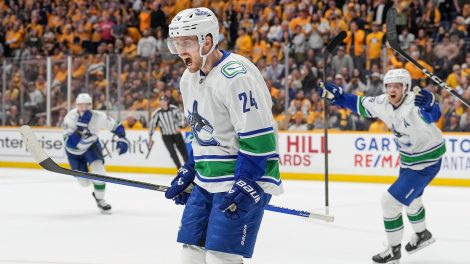TORONTO — If your only glimpse of quick-trigger winger Daniel Carr had happened to fall on Dec. 5, 2015, you’d have thought it was all too easy for him.
It was just two minutes and 44 seconds into the then-24-year-old’s NHL debut when he found himself with an extra breath’s worth of time behind the Carolina Hurricanes’ cage. Goaltender Cam Ward shifted nervously in front of him. Carr’s own Montreal Canadiens teammates hovered briefly at the net-front, unsure if the new kid had the foresight or the mitts to dish the puck back into the slot.
But before that extra breath had even escaped into the PNC Arena air, Carr slipped around to Ward’s left side, tucked the puck past the netminder’s left skate, and brought the goal horns out. A slick-handed, buttery-smooth first goal on his first shift in his first NHL game — as if to pay homage to Mario Lemieux in the colours of Le Magnifique’s hometown squad.
As it turns out, that three-minute snapshot wasn’t necessarily indicative of the big-league career that was to come — not to mention his pre-NHL history. Carr currently suits up for the Vegas Golden Knights‘ AHL affiliate, the Chicago Wolves. But throughout the Sherwood Park, Alta., native’s winding journey, one thing has remained constant: Nothing given, everything earned.
[snippet id=3653171]
It began for Carr like it does for most Alberta boys. Hailing from the Strathcona County area, where Rogers Hometown Hockey touches down this weekend, he started with stints on teams all around the province — first Fort Saskatchewan, then Leduc, and then St. Albert. He’d been taught the finer details of the game by his father, former University of Alberta Golden Bears great Jim Carr, who passed on years of lessons learned from his own longtime coach, Hall of Famer Clare Drake.
But when the final bell had rung on Carr’s Alberta Junior Hockey League tenure, his path veered right where all those around him swung left.
“I think I’m kind of an exception from Alberta because hockey in Alberta is so dominated by the Western Hockey League,” Carr says. “You go to those U16 [teams] and all those teams, and it’s just all anyone speaks about — the Western league. So I’m so grateful I got to go to college.”
Quite a bit more than just “go,” in fact.
His four years at Union College in Schenectady, N.Y., were trophy-filled affairs. An all-rookie team nod in Year 1. Regular-season and ECAC Hockey conference championship in Year 2, along with a place on the all-tournament team. The latter two honours repeated in Year 3, and then, in his final season, the big prize.
In 2014, Carr’s Union College took out national powerhouses Minnesota and Boston College en route to its first-ever NCAA championship. That senior year also saw the winger earn ECAC tournament MVP honours and a spot on the conference all-tournament team for the third straight year. Not a bad way to go out.
While he pocketed his fair share of unforgettable memories and friendships with Union teammates, like fellow alternate captain and eventual Philadelphia Flyers blueliner Shayne Gostisbehere, those college years wound up granting Carr something far more valuable — the time to hone his craft.
It’s one of the myriad underrated quirks that come with opting for an NCAA career over a stint in the CHL. Though the prevailing assumption in the hockey world is that the Canadian junior leagues remain the premier route, the arrival of more and more dominant NHLers coming out of college programs each year suggests there’s something to be said of the American system’s ability to foster star power.
“From a hockey perspective, in college you only play 40 games, so you get to practice a lot more. You only play on the weekends, so you actually get to do a lot more skill development, a lot more training in the gym,” Carr says. “You know, when you turn pro, you’re a lot more ready for what pro brings, both on and off the ice. You graduate from college and you’re an adult. Even if you’re only one or two years older than the guys coming out of juniors, you’ve been through so much more in school, been on your own for four years already.
“You come out and you’re just ready for it, ready for the ups and downs of pro hockey and ready for the challenges that you face in pro.”
Don’t think NHL clubs aren’t well aware of those advantages, or of the heightened value in bringing aboard players that have had that extra time to marinate in 24-seven hockey life. The NHL has seen the number of NCAA alums among its ranks rise steadily in recent years, with the 2018-19 campaign featuring a record number of college alums on big-league rosters (209).
Part of the reason for that increase is the flexibility that comes with adding an NCAA player as opposed to a CHL alum, according to those running the NHL club just a few hours south of Carr’s hometown.
“College is for guys that need a little bit more time,” Calgary Flames assistant GM Craig Conroy said over the phone back in March. “When we drafted Johnny [Gaudreau], when we drafted [Mark] Jankowski, we thought ‘Okay, he might take a little while.’ They’re probably not ready that next year or year after, so it works out well for us — you don’t have to give those guys a contract [until] as long as four years away.
“So to have them kind of in the organization, getting better year in and year out, and then when they finally are ready — you know, Johnny after his third year, Jankowski went to all four years — it’s the one advantage you kind of have over a junior player, [where in] two years you have to make a decision.”
[sidebar]
That distinction regularly comes into play during the NHL Draft’s later rounds for the Flames scouting staff, whose own prized NCAA alum, Johnny Gaudreau, was part of the Boston College side that fell to Carr’s Union College during that 2014 national title run.
“It’s absolutely a key decision-maker when you’re drafting players,” Tod Button, director of amateur scouting for the Flames, added. “For sure, if you go down your list and you have two comparable players, and they both need the same amount of strength training and maturity and experience, and everything is equal, then sure you can give an edge to a guy going to college…. Because you do have more time with them and you can watch them mature.”
For Carr, the time spent maturing in the NCAA before his NHL days set him up to navigate the complicated nature of his particular relationship with the Canadiens, specifically the manner in which he was brought in.
“I was pretty lucky in college that we had a coach that had played and knew it was going to be hard for the guys that were gonna go and try to play pro hockey…. He understood that it was never going to be easy for guys like me, that were free-agent signings,” Carr says. “You know, teams don’t have as much invested in you — you’re just a contract, right? You’re not a draft pick, nobody kind of stuck their neck out for you, and so you’ve gotta claw for everything you get.”
[relatedlinks]
In all, he played 94 total games for the Canadiens and another 139 for Montreal’s AHL-affiliated teams. And this season playing for the AHL Wolves he’s taken his playmaking to the next level, notching 17 goals and 23 assists in just 29 games as he waits for another shot at NHL action with the Golden Knights.
The Canadiens stint offered him a number of lessons to further his career — one of the most valuable was an up-close viewing of the blueprint for how to will one’s way to a successful big-league career, the architect none other than fellow Sherwood Park native Brendan Gallagher.
“Gally’s earned everything he’s gotten,” Carr says of his former teammate. “He plays hard every game. And I don’t think people realize how hard that is to do when you play 82 games. You know, even if he doesn’t have it necessarily 100 per cent one night, his effort is there 100 per cent every night. And I think that’s what’s gotten him to where he is today. You learn from seeing his success, from things like that, and you try to do the same thing yourself every night.”
There’s only so much learning needed on that front, though. Because, truth be told, that hard-nosed approach is already deeply rooted in Carr’s nature. It has been from Day 1, the seed planted during his early days learning the game in Alberta.
It’s simply the way things are done out west, the winger says.
“You get a lot of the same attributes from players from Alberta, Saskatchewan and Manitoba — those three provinces,” says Carr. “In general — obviously with some exceptions — all the guys from the western provinces play the same way. There’s a lot of emphasis on skill but there’s a lot of emphasis on playing hard.
“Guys talk about playing hockey ‘the right way,’ and I think you see a lot of that out of guys from Alberta.”








